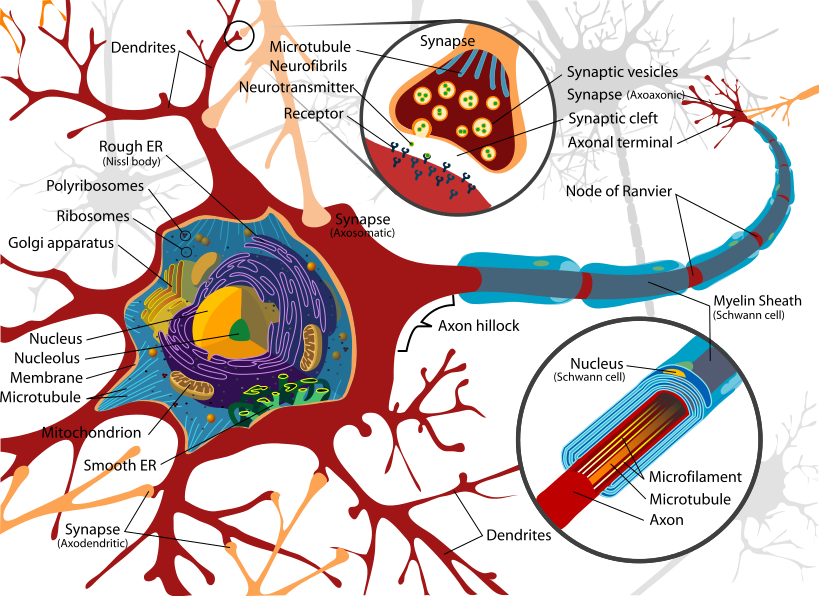Essential idea: Neurons transmit the message, synapses modulate the message.
The image above shows a tiny segment of a model of a mouse brain the lines show neurons and the dots show synapses. The image is intended to illustrate both the how complex even a small mammal's brain is and additionally how important the synapses between neurons are; it is the synapses that drive communication and conscious thought. With the exception of the memory centre the number of cells in the human brain does not increase after birth, what increase is the number of connections and hence synapses between neurons.
Understandings, applications and skills
| 6.5.U1 | Neurons transmit electrical impulses. [The details of structure of different types of neuron are not needed.] |
| 6.5.U2 | The myelination of nerve fibres allows for saltatory conduction. |
| 6.5.U3 | Neurons pump sodium and potassium ions across their membranes to generate a resting potential. |
| 6.5.U4 | An action potential consists of depolarization and repolarization of the neuron. |
| 6.5.U5 | Nerve impulses are action potentials propagated along the axons of neurons. |
| 6.5.U6 | Propagation of nerve impulses is the result of local currents that cause each successive part of the axon to reach the threshold potential. |
| 6.5.U7 | Synapses are junctions between neurons and between neurons and receptor or effector cells. [Only chemical synapses are required, not electrical, and they can simply be referred to as synapses.] |
| 6.5.U8 | When presynaptic neurons are depolarized they release a neurotransmitter into the synapse. |
| 6.5.U9 | A nerve impulse is only initiated if the threshold potential is reached. |
| 6.5.A1 | Secretion and reabsorption of acetylcholine by neurons at synapses. |
| 6.5.A2 | Blocking of synaptic transmission at cholinergic synapses in insects by binding of neonicotinoid pesticides to acetylcholine receptors. |
| 6.5.S1 | Analysis of oscilloscope traces showing resting potentials and action potentials. |
[Text in square brackets indicates guidance notes]
Starters
|
What would the world be like if you could feel no pain?
Would it be like having a superpower? In a very rare condition Congenital insensitivity to pain with anhidrosis (CIPA) some people cannot sense pain. Watch the video to learn more. |
How do nerves work?
A TED-Ed lesson introducing nerve impulses by Elliot Krane |
Presentation and Notes
The presentation is designed to help your understanding.
|
The 6.5 Neurons and synapses notes - the bottom line template can be used as a note construction template in itself or as a checklist if you are using your own or another template such as the Cornell style template.
|
Structure of a neuron
You are not required to draw and label a neuron, but never-the-less you need to understand it's fascinating structure to appreciate it's function.
Weblinks
Nature of science
Cooperation and collaboration between groups of scientists—biologists are contributing to research into memory and learning. (4.3)
Higher functions of the brain including memory and learning are only partly understood at present and are being researched very actively. They have traditionally been investigated by psychologists but increasingly the techniques of molecular biology and biochemistry are being used to unravel the mechanisms at work. Other branches of science are also making important contributions, including biophysics, medicine, pharmacology and computer science.
The Centre for Neural Circuits and Behaviour at Oxford University is an excellent example of collaboration between scientists with different areas of expertise. The four group leaders of the research team and the area of science that they originally studied are:
Higher functions of the brain including memory and learning are only partly understood at present and are being researched very actively. They have traditionally been investigated by psychologists but increasingly the techniques of molecular biology and biochemistry are being used to unravel the mechanisms at work. Other branches of science are also making important contributions, including biophysics, medicine, pharmacology and computer science.
The Centre for Neural Circuits and Behaviour at Oxford University is an excellent example of collaboration between scientists with different areas of expertise. The four group leaders of the research team and the area of science that they originally studied are:
- Professor Gero Miesenböck – medicine and physiology
- Dr Martin Booth – engineering and optical microscopy
- Dr Korneel Hens – chemistry and biochemistry
- Professor Scott Waddell – genetics, molecular biology and neurobiology.
Theory of knowledgeWatch the TED video to find out how neurons shaped civilization by V S Ramachandran.
|
|


